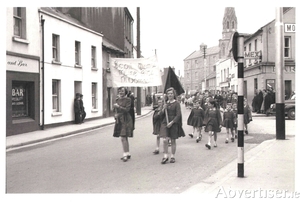Search Results for 'The Galway Express'
26 results found.
St. Mary’s College — the early days

It was about this time of year, May 26, 1910 that the foundation stone of St. Mary’s College was laid. It was not, however the first St Mary’s College. Father John Paul O’Toole, born in Galway in 1804, was one of the last priests ordained during the wardenship. He was based in Paris and Rome but was always conscious of his own difficulty in obtaining a food secondary education in Galway, so he decided to return to Galway in 1843 and open a school here. His main difficulty was finding a premises but happily, he managed to secure “West House”, a detached residence with extensive grounds situated on Helen Street. He bought it from John Lushington Reilly, a great benefactor of the town and neighbourhood, especially during the famine of 1822.
St Patrick’s Day parades of yesteryear

St Patrick may never have made it to Galway, I could not find any legend that associates him with the city, except maybe for anyone who went to Athenry to get their arse painted green. The anniversary of the saint’s death has been celebrated for many generations and the central focus of the day was usually the parade.
Wild nights of burning and murder

Clifden was not the only town to experience the terror of British forces running wild, shooting, and setting fire to buildings. The previous year, July 19 1920, Tuam suffered a similar experience as Clifden, only mercifully no resident was killed on that occasion.
The extraordinary Fr Peter Daly walks on to the Galway Stage

In the early decades of the 19th century fortunes were made in giving hundreds of thousands of emigrants safe passage to America. As the decades slipped by the numbers grew into millions. Liverpool had the main transatlantic business for these two islands, but Galway, situated some 300 miles closer to America, and with the onset of powerful steam-driven ships, believed that a better and quicker service could be provided.
Old Galway newspapers

The first book printed in Ireland was The Book of Common Prayer in 1551. As printing became more sophisticated, newspapers became inevitable. The first gazettes were published originally in manuscript – the word gazette being derived from gazetto, a coin of Venice, the amount paid for reading the news. The earliest printed newspapers began to appear around the end of the 16th century. These were small, quarto in size, printed on one or both sides of the page, or of four pages containing intelligence of public interest which were variously called 'Books of Newes', ‘Newe Newes’, 'Wonderful Newes', ‘Bloody Newes out of Ireland’, etc.
The British raid on Inis Mór, December 1920

November 1920 was a bloody month in Galway with the killing of Eileen Quinn, Fr Michael Griffin, Michael Moran, and Harry and Patrick Loughnane. D Company Auxiliaries had made their presence felt.
100 years since Oranmore’s Joe Howley was shot

In the centre of Oranmore, stands a statue to a local man who was shot in Dublin one hundred years ago this week. Joe Howley, Officer Commanding Number One Brigade IRA Galway was killed leaving what is now Heuston Station, Dublin on December 4 1920, and was pronounced dead at 12.30 a.m. December 5 in George V Hospital Dublin.
The Black and Tans' raid on O’Flaherty’s Pub

The tall building in the centre of our picture of New Docks Road taken in 1903 was known as “Gas Tank” Flaherty’s pub. We presume he got his nickname because of the gasworks across the street. It was here that the distinguished English painter Augustus John lived for several weeks in 1914. He did a lot of painting and drawing around the city and especially the docks area, but when the World War I started, he began to worry that the locals would regard him as an English spy, so he went back to England.



